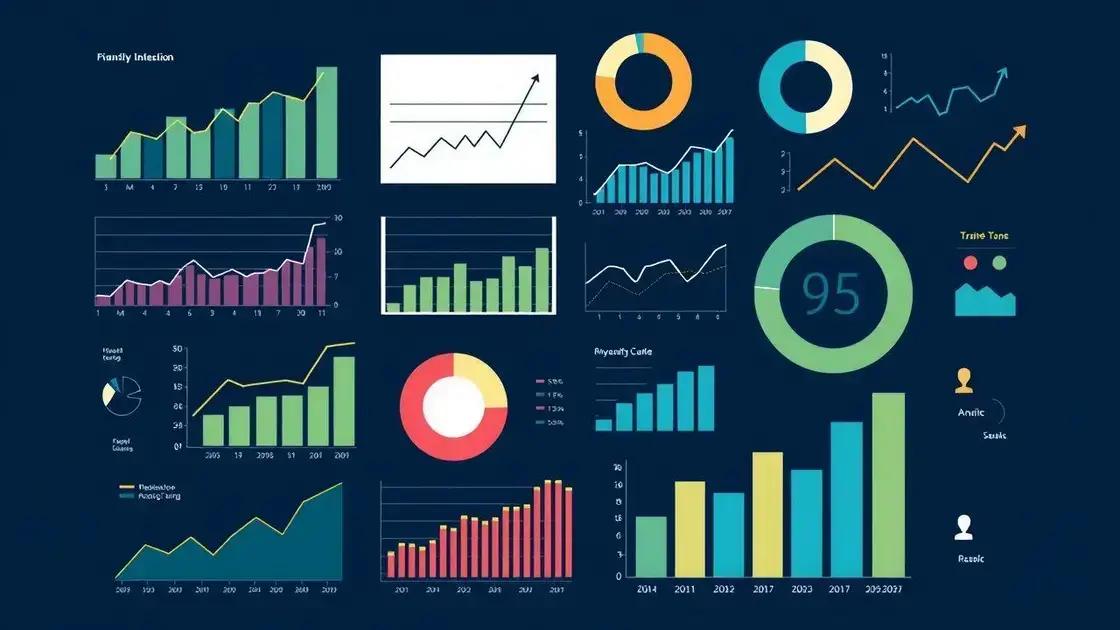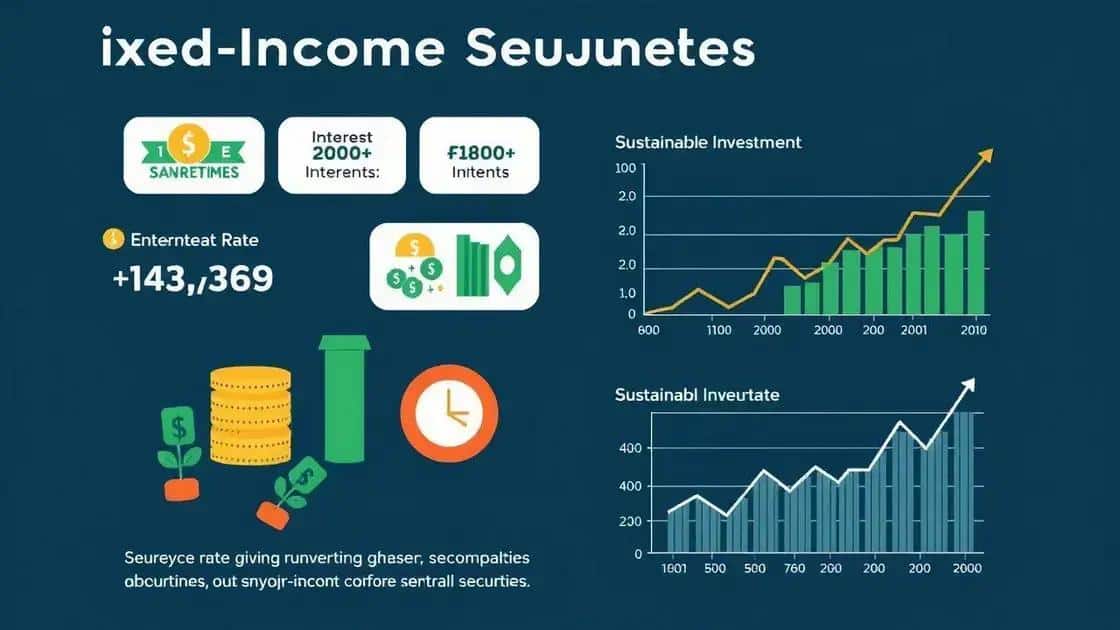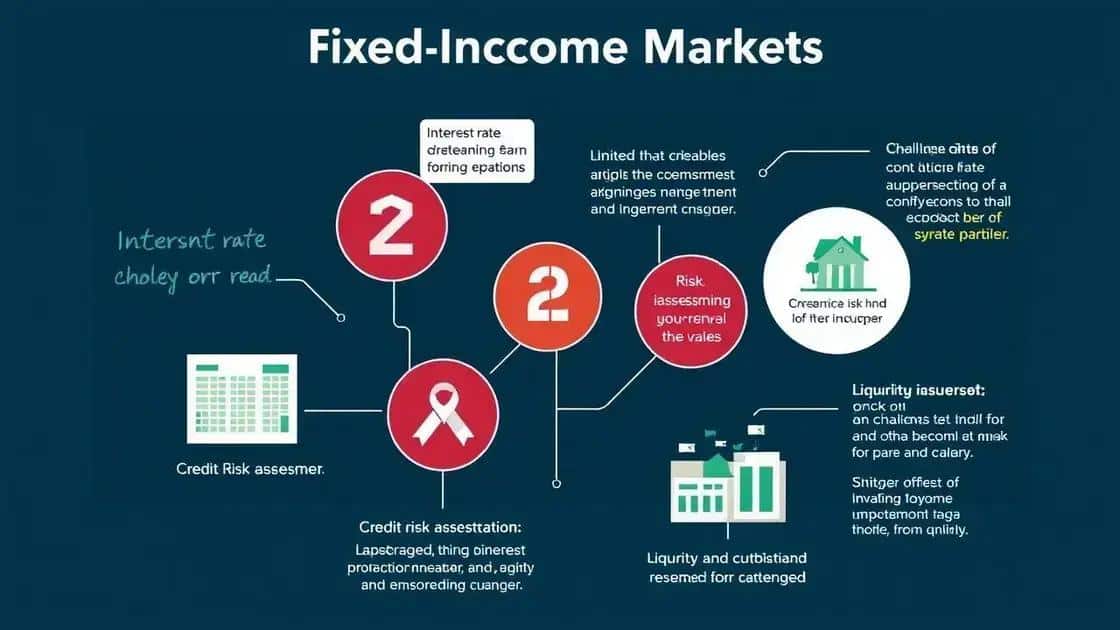Insights on fixed-income investment trends: what to know

Insights on fixed-income investment trends reveal that rising interest rates, increased demand for sustainable investments, and a focus on credit quality are reshaping the market, making diversification and risk management essential for success.
Insights on fixed-income investment trends are essential for anyone looking to diversify their portfolio. With changing economic conditions, how can you make informed decisions in this area? Let’s explore.
Understanding fixed-income investments
Understanding fixed-income investments is crucial for anyone eager to build a stable financial future. These investments offer a predictable return, making them attractive in varying economic climates. Let’s dive deeper into what fixed-income investments are all about.
What are fixed-income investments?
Fixed-income investments are debt securities issued by governments, corporations, or municipalities. They provide investors with regular interest payments until maturity, at which point the principal is returned. This structure allows for a steady stream of income in contrast to more volatile investments like stocks.
Benefits of fixed-income investments
Investing in fixed-income can fit well into your financial strategy. Below are some key benefits:
- Stable income: Regular interest payments provide reliable returns.
- Lower risk: Generally less risky than stocks, offering more stability.
- Portfolio diversification: Balances out more volatile investments in your portfolio.
Many investors appreciate these characteristics, especially during times of market uncertainty. These qualities make fixed-income options particularly appealing.
Types of fixed-income investments
There are various types of fixed-income securities available in the market:
- Bonds: Long-term debt instruments.
- Treasury securities: Government-issued bonds, considered very safe.
- Municipal bonds: Issued by local governments, often offering tax benefits.
- Corporate bonds: Bonds issued by companies, typically with higher yields.
Each type offers unique advantages, so understanding their differences is essential for effective investing.
While fixed-income investments are less volatile, they are not without risks. Interest rate changes can impact their performance significantly. When rates rise, the value of existing bonds may drop, influencing returns negatively. Thus, being aware of market trends is vital for anyone considering these investments.
Current trends in fixed-income securities

Current trends in fixed-income securities reflect the evolving dynamics of global markets. Investors today need to stay informed about these shifts to make wise investment decisions. Let’s explore some of the significant trends impacting this asset class.
Rising Interest Rates
One of the most notable trends is the rise in interest rates. As central banks increase rates to combat inflation, fixed-income securities can see volatility. Higher rates generally mean lower prices for existing bonds, affecting their attractiveness. Investors need to consider the impact of rising rates when assessing their portfolios.
Increased Demand for Sustainable Investments
Another growing trend is the demand for sustainable and green bonds. More investors are looking to allocate funds to projects that promise environmental benefits. These bonds are not only appealing for their returns but also for their impact on climate change. The influx of capital into sustainable investments shows the shift in what investors find valuable.
Shift Toward Shorter Durations
Given the current uncertainties, many investors are favoring shorter-duration bonds. These securities allow for quicker exits and provide more flexibility in a fluctuating interest rate environment. Short-term bonds typically carry lower risk and offer less exposure to interest rate changes.
Focus on Credit Quality
In today’s landscape, there is an increased focus on credit quality. Investors are paying closer attention to the credit ratings of bond issuers. With potential defaults becoming a concern, securing higher-rated securities has become a priority.
As the fixed-income market evolves, it is essential to be aware of these trends. By understanding factors such as rising rates, sustainable investments, shorter durations, and credit quality shifts, you can navigate this complex environment more effectively.
Strategies for successful fixed-income investing
Strategies for successful fixed-income investing are essential for achieving your financial goals. Knowing where to invest and how to diversify your portfolio can make a significant difference. In this section, we will explore key strategies to enhance your fixed-income investments.
Diversification is Key
Diversifying your investments reduces risk and increases potential returns. Spread your funds across various types of fixed-income securities, such as governmental bonds, corporate bonds, and municipal bonds. This can help mitigate losses if one type performs poorly.
Consider the Duration
Duration is a crucial factor in fixed-income investing. Short-duration bonds may offer less risk, while long-duration bonds can yield higher returns but with more volatility. Assess your risk tolerance and investment goals to find the right balance between duration and potential return.
Monitor Interest Rates
Interest rates play a critical role in fixed-income investments. Stay informed about rate changes to adjust your portfolio accordingly. If rates rise, the value of your existing bonds may decrease, making it a necessity to anticipate these changes.
Research Credit Ratings
Before investing, always check the credit ratings of the bonds you are considering. Higher-rated bonds tend to be less risky but typically offer lower yields. Conversely, lower-rated bonds can offer higher returns but come with increased risk. Understanding these ratings can help you make informed decisions.
Having a clear strategy will guide you in navigating fixed-income investments successfully. Remember to continually reassess your portfolio and stay updated on market trends and economic indicators. This proactive approach can lead to better outcomes in your investment journey.
Risks and challenges in fixed-income markets

Risks and challenges in fixed-income markets can significantly impact your investment decisions. Understanding these risks is essential for successful investing. Here, we will explore some key risks and challenges that investors face.
Interest Rate Risk
Interest rate risk is one of the biggest challenges in fixed-income investing. When interest rates rise, the market value of existing bonds tends to fall. This can lead to potential losses for investors if they need to sell their bonds before maturity. Staying informed about economic indicators and central bank policies can help in managing this risk.
Credit Risk
Credit risk refers to the possibility that a bond issuer will default on payments. This risk is higher with corporate bonds than with government bonds. Investors must evaluate the credit ratings of issuers before investing. Strong credit ratings indicate lower risk, while lower ratings mean higher potential rewards but also a greater chance of default.
Inflation Risk
Inflation risk affects purchasing power. If inflation increases significantly, the fixed interest payments from bonds could lose value over time. This means that, although investors receive the same nominal amount, their real income may decrease. To hedge against this, consider investing in inflation-protected securities.
Liquidity Risk
Liquidity risk can be a significant issue in fixed-income markets. Some bonds may be difficult to sell quickly without a substantial price drop. This can pose a problem if you need to access your funds. Investing in more liquid markets or choosing widely traded bonds can help mitigate this concern.
Navigating the risks and challenges in fixed-income markets requires careful planning and ongoing education. By understanding these factors, you can make more informed decisions that align with your financial goals.
In conclusion, understanding the world of fixed-income investments is vital for anyone looking to secure their financial future. By being aware of the trends, strategies, and risks, investors can make informed choices. Remember, diversification, monitoring interest rates, and evaluating credit risks are key elements to success in this area. Stay proactive and adaptable to navigate the fixed-income market effectively.
FAQ – Frequently Asked Questions about Fixed-Income Investments
What are fixed-income investments?
Fixed-income investments are debt securities that provide regular interest payments and return the principal at maturity, such as bonds and treasury securities.
What risks are associated with fixed-income investing?
Key risks include interest rate risk, credit risk, inflation risk, and liquidity risk, all of which can affect your returns and investment strategy.
How can I manage interest rate risk?
You can manage interest rate risk by diversifying your bond portfolio, focusing on shorter-duration bonds, and staying informed about economic indicators.
Why is diversification important in fixed-income investing?
Diversification helps reduce risk by spreading investments across different types of fixed-income securities, which can enhance overall returns and provide stability.





